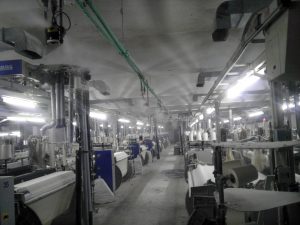Textile
Weaving process
Process
The weaving process is the textile process of making a fabric. A fabric is made by crossing warp threads and usually a single weft thread. The warp threads are in the direction of the length of the fabric. They are unwound from the warp beam. The loom opens the warp by means of boards. Some threads are pulled up and others down.
The weft thread is introduced into the passage thus created between the warp threads (top and bottom). Then the position of the boards is reversed, which clamps the weft thread that has just been introduced. The beater comes to strike the work done, to align the weft thread with the previous ones. Then the next cycle begins. The threads advance, rub and are subjected to repeated tension. The weft thread is inserted at very high speed. This is a delicate operation. Finally, the edges of the fabric are called selvedges. The unfinished fabric, which is not treated, dyed or bleached, is called ecru.
The weaving is made with the assistance of weaving looms. However, before inserting the warp and filling in the looms, different treatments are provided, and a thorough preparation must take place entailing in threading each warp end. Moreover, packaging the filling yarn in a simple form, will allow for an easy unwinding, through the shed or shuttle.
Furthermore, the loom machines can assist in the fabrication of basic and exquisite fabrics, by interlacing the two types of thread, wrap and weft, by passing the fabrics through 4 series of steps:
- Shedding
- Picking
- Beating up
- Taking up
The basic weaves are plain, satin and twill. The production of elaborate weaves is also possible on specially adapted looms:
- Velvet
- Jacquard
Occurring issues as a repercussion of inappropriate relative humidification level
The development of the above types of weaves is possible through machines such as Air Jet Loom, Rapier or Jacquard Loom. These looms require spot humidification, to prevent the yarn from breakage, or weft from jamming. If the yarn is broken this causes multiple issues as:
- Stopping the machine;
- requiring the broken yarn to reconnect;
- deteriorating the quality of the product;
- decreasing the working efficiency.
Solutions
Solutions to prevent issues and improve the weaving process
During the weaving process, where the fabrics are placed in the looms, if the moisture and humidity levels are inadequate, this could lead to the drying the weft. When the threads are dry, they could break. Moreover, the dry air also leads to the occurrence of electrostatic discharges. To prevent this from happening, the AKIMist “E”’s “Dry Fog” will not only assist in regulating the level of relating humidity, moisturizing sufficiently the threads, but also will humidify without wetting the looms.

